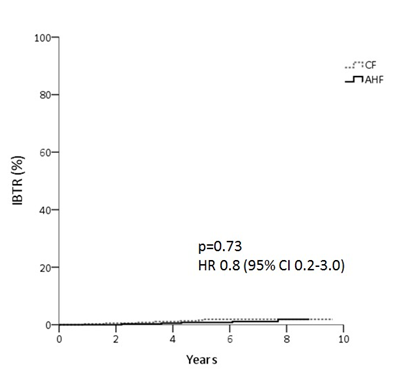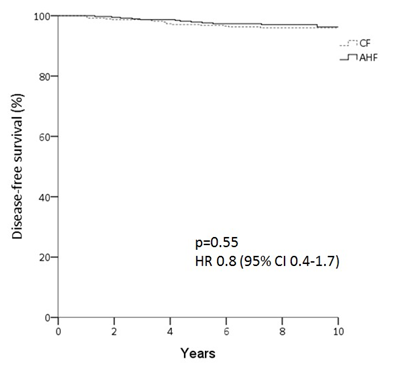글로벌 연구동향
방사선종양학
![[Medicine (Baltimore).] A Comparative Study of Daily 3-Gy Hypofractionated and 1.8-Gy Conventional Breast Irradiation in Early-Stage Breast Cancer.](/enewspaper/upimages/admin_20160711144655_R.jpg) 2016년 07월호
2016년 07월호
[Medicine (Baltimore).] A Comparative Study of Daily 3-Gy Hypofractionated and 1.8-Gy Conventional Breast Irradiation in Early-Stage Breast Cancer.서울의대 / 이시원, 김연주, 신경환*
- 출처
- Medicine (Baltimore).
- 등재일
- 2016 May
- 저널이슈번호
- 95(19):e3320. doi: 10.1097/MD.0000000000003320.
- 내용
A

B
Figure 1. Cumulative incidence of ipsilateral breast tumor recurrence (IBTR) (A) and disease-free survival (B) for patients after accelerated hypofractionation (AHF) or conventional fractionation (CF) radiation therapyAbstract
We retrospectively compared accelerated hypofractionation (AHF) with conventional fractionation (CF) in the radiation therapy (RT) for early-stage breast cancer patients.Three hundred seventy-nine early-stage (pT1-2 and pN0-1a) breast cancer patients who received RT with AHF after breast-conserving surgery (BCS) were included. These patients were matched with 379 corresponding patients who received BCS and RT with CF at a different center with respect to the year BCS was performed, patient age (±3 years), and cancer stage. The AHF regimen consisted of 39 Gy in 13 fractions to the whole breast and a consecutive boost of 9 to 12 Gy in 3 to 4 fractions to the tumor bed. CF comprised whole-breast irradiation up to 50.4 Gy in 28 fractions and a boost of 9 to 14 Gy in 5 to 7 fractions to the tumor bed.The median follow-up period was 75 months (range, 3.8-110.8 months). There was no statistically significant difference between the AHF and CF groups in terms of age distribution, T and N stage, resection margin, and histologic grade. There were 5 ipsilateral breast tumor relapse (IBTR) cases in the AHF group compared with 7 cases in the CF group. Seven and eight locoregional relapse (LRR) cases were observed in the AHF and CF groups, respectively. The 7-year rates of IBTR-free survival, LRR-free survival, and disease-free survival were 98.9%, 98.4%, and 97.1% in the AHF group and 98.1%, 97.9%, and 96.0% in the CF group, respectively (P > 0.05). The incident rates of grade 3 edema, hyperpigmentation, or wet desquamation at the end of RT were higher in the CF group than in the AHF group (16.4% vs 0.2%, respectively; P < 0.01).AHF RT of 39 Gy to the whole breast plus a 9-Gy boost in 16 fractions showed excellent tumor control and tolerable skin toxicity, a finding that is comparable to CF RT in patients with early-stage breast cancer.
Author information
Lee SW1, Kim YJ, Shin KH, Kim K, Chie EK, Han W, Im SA, Jung SY, Lee KS, Lee ES.
1From the Seoul National University College of Medicine, Seoul (S-WL, KHS, KK, EKC, WH, S-AI); and Research Institute and Hospital, National Cancer Center, Goyang, Korea (Y-JK, S-YJ, KSL, ESL).
- 연구소개
- 일일선량 1.8 Gy, 33-35회, 총선량 59.4-63 Gy의 기존 전체유방 방사선치료와 3 Gy, 16-17회, 48 Gy의 저분할 방사선치료를 비교한 논문입니다. 중앙추적기간 75개월간 추적 관찰 후 7년 국소조절율, 무병생존율에서 양 치료군간 차이가 전혀 없었고 방사선치료 종료시 중증도 3인 유방부종, 색소침착, 습성 박리 등 방사선치료 부작용은 오히려 저분할 방사선치료군에서 의미있게 적게 나타나 기존 6-7주 치료기간을 3-4주로 안전하게 단축시킬 수 있음을 보고하였습니다.
- 덧글달기
- 이전글 [Radiother Oncol.] Timely tumor response analysis after preoperative chemoradiotherapy and curative surgery in locally advanced rectal cancer: A multi-institutional study for optimal surgical timing in rectal cancer.
- 다음글 [Onco Targets Ther.] Analysis of prostate bed motion using an endorectal balloon and cone beam computed tomography during postprostatectomy radiotherapy.







